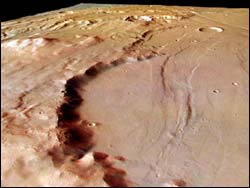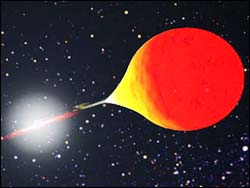Physics and Astronomy
This area deals with the fundamental laws and building blocks of nature and how they interact, the properties and the behavior of matter, and research into space and time and their structures.
innovations-report provides in-depth reports and articles on subjects such as astrophysics, laser technologies, nuclear, quantum, particle and solid-state physics, nanotechnologies, planetary research and findings (Mars, Venus) and developments related to the Hubble Telescope.

Solis Planum, Thaumasia region
These images, taken by the High Resolution Stereo Camera (HRSC) on board ESA’s Mars Express spacecraft, show part of a heavily eroded impact crater at Solis Planum, in the Thaumasia region of Mars.
The images were taken during orbit 431 in May 2004 with a ground resolution of approximately 48 metres per pixel. The displayed region is located south of Solis Planum at longitude 271° East and latitude of about 33° South.
The larger eroded impact crater in the lower left of thi

Yale scientists bring quantum optics to a microchip
A report in the journal Nature describes the first experiment in which a single photon is coherently coupled to a single superconducting qubit (quantum bit or “artificial atom”).
This represents a new paradigm in which quantum optics experiments can be performed in a micro-chip electrical circuit using microwaves instead of visible photons and lasers. The work is a collaboration of the laboratory of Professor Robert Schoelkopf and the theory group of Professor Steven Girvin in the

Mars may have had large sea near NASA rover landing site
Spacecraft observations of the landing area for one of NASA’s two Mars rovers now indicate there likely was an enormous sea or lake covering the region in the past, according to a new University of Colorado at Boulder study.
Research Associate Brian Hynek of the Laboratory for Atmospheric and Space Physics said data from the Mars Global Surveyor and Mars Odyssey spacecraft now show that the region surrounding the Opportunity rover’s landing site probably had a body of water at leas

UK scientist gambles on gravitational waves
At the Institute of Physics conference Photon 04 yesterday, Professor Jim Hough, one of the UK’s leading scientists, revealed that he thinks high street bookmakers are crazy to be offering odds of 100-1 on whether Gravitational Waves (wrinkles in relativity) will be discovered before 2010. He has placed a personal bet of £25 – the maximum Ladbrokes allowed him to stake. The available odds were quickly cut from an initial offering of 500-1.
Professor Jim Hough, from the Universi

Scientists Glimpse Exotic Matter in a Neutron Star
Scientists have obtained their best measurement yet of the size and contents of a neutron star, an ultra-dense object containing the strangest and rarest matter in the universe.
The measurement may lead to a better understanding of nature’s building blocks — protons, neutrons and their constituent quarks — as they are compressed inside the neutron star to a density trillions of times greater than on Earth.
Tod Strohmayer of NASA Goddard Space Flight Center in Greenbelt,

UK scientists detect new ring and one, possibly two, objects at Saturn
The joint NASA/ESA/ASI Cassini-Huygens mission is continuing to provide a fascinating insight into the Saturn system. The latest detection of one small body, possibly two, orbiting in the planet’s contorted F ring region and a ring of new material associated with Saturn’s moon Atlas, has been made by a team of UK scientists.
A small object was discovered moving near the outside edge of the F ring, interior to the orbit of Saturn’s moon Pandora. The object was first seen by Professor C